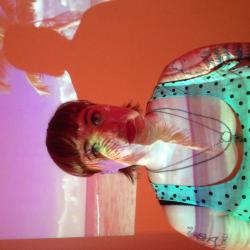Ásrún Magnúsdóttir sits in a relaxed slouch in a Prikið booth, legs and arms shifting into stretches of repose as she talks, hands open and active, her whole face aglow in a wide impish grin. The dancer and choreographer is in a whirlwind of pre-show stress and excitement as her dance piece ‘GRRRRRRLS’ is on the cusp of its fourth run of performances. She seems proverbially and appropriately schoolgirlish in her anticipation, and utterly composed and assured about her creation at once. “It’s quite different now, because since the premiere I had a baby and I’ve been off thinking about other things,” says Ásrún. “They understood it more, I understood it more. Something really clicked.”
They would be the seventeen teenage girls, now aged thirteen to sixteen, that Ásrún has been working with since 2015 to create the show. The girls came to take part by responding to an open call for dancers issued two years ago. “I didn’t want to have auditions, because I wanted anyone who wanted to take part in it to be able to,” says Ásrún. “Most of them, but not all, have done some dancing, and all on a different scale. Some of them are strict ballerinas, and some of them do different types of dance.” Ásrún emphasises that the girls collaborated on creating the work, rather than having an authority figure’s vision imposed on them.

Girl gang
Her goal was to draw out their ideas and get them involved in the process. “They are supposed to make the material and decide what we do, how we deliver it and what goes on stage,” she says. “It was challenging for them in the beginning. Now they know each other, so it’s very different. But at first they were not used to it. Usually it was somebody creating something on them, and this time it wasn’t like that. Of course in the end it’s never that romantic—I’m always at the top, but I try to make it not feel like that.”
The emphasis of having the girls put their minds and bodies into the creative process was a direct way to tap into the power she sees in teenage girls, and to give them an outlet to embody what their role models teach them. “We have constantly been talking about which artists in this scene are important to them,” explains Ásrún. “They talk a lot about Reykjavíkudætur and Salka Sól from Abamadama. These artists have really big influence on them—women who are creating, taking power, and speaking out loud. Being out there, basically.” It’s this energy she has worked on channelling into movement; into a sense of agency, identity, love, and connection with other girls.



Peer decompressure
Through this process, and since the first run of the show in August 2015, the girls have fallen into the flow of creating and communicating through the process with each other. They have simultaneously experienced the growth of the piece alongside their individual maturing. “The girls went from being as young as twelve to now as old as sixteen,” says Ásrún. “One of them said to me, ‘I didn’t understand it last time we were doing it, but now I get it. It’s about us, our vision, how we stand together. It’s about us taking power.’ They know now that they can talk together on stage, they can look at each other, they can communicate. It’s really about listening to each other. It’s really about the listening, in the end, and not about the others that are watching.”
By having the girls focus on each other during the performances rather than on the audience’s perception, the girls are able to sidestep the perfectionism of the dance world. “I think for kids and teenagers there’s this thing where there’s no room for mistakes, there’s always this pressure for perfection,” says Ásrún. “Often when you’re doing a dance piece you’re performing for someone else and everything needs to be perfect, especially if you have a dance history in your body, then you’re maybe stressed about this. This piece is completely the opposite, and they get that.”

Rearview mirror
Ásrún herself, now a young mother, gets to channel her nostalgia and have a second adolescence through their youthful wisdom. “They’re so aware. They’re so smart. They’re much smarter and much more aware than I was at their age. It’s so intimidating!” she laughs. “I missed being a teenager, and I wondered if it was different for them now. I was just a really normal teenager but the other day I found my old diaries and they were more brutal than I would have imagined. I was like: ‘wow I was so dramatic!’”
Although she considers the young women she has been working with for the past two years wiser than she was, the element of drama and the soft trauma that are the teenage years always figure strongly. Pieces are dedicated to former “lovers”—a grand term to use at the most tender of ages—and also to best friends, and to mothers—a deeply complex relationship for most girls at some point.
The strongest reactions to the show have come from young girls and mothers, but the greatest victory Ásrún feels is the fact that the show has reached far beyond the dance community. She hopes this marks a growing interest in dance, and an opportunity to continue into the future by also working with boys.
The closing performance of GRRRRRRLS takes place at Tjarnabíó on Friday, March 10 at 21:00. Tickets available on midi.is.




Buy subscriptions, t-shirts and more from our shop right here!
















